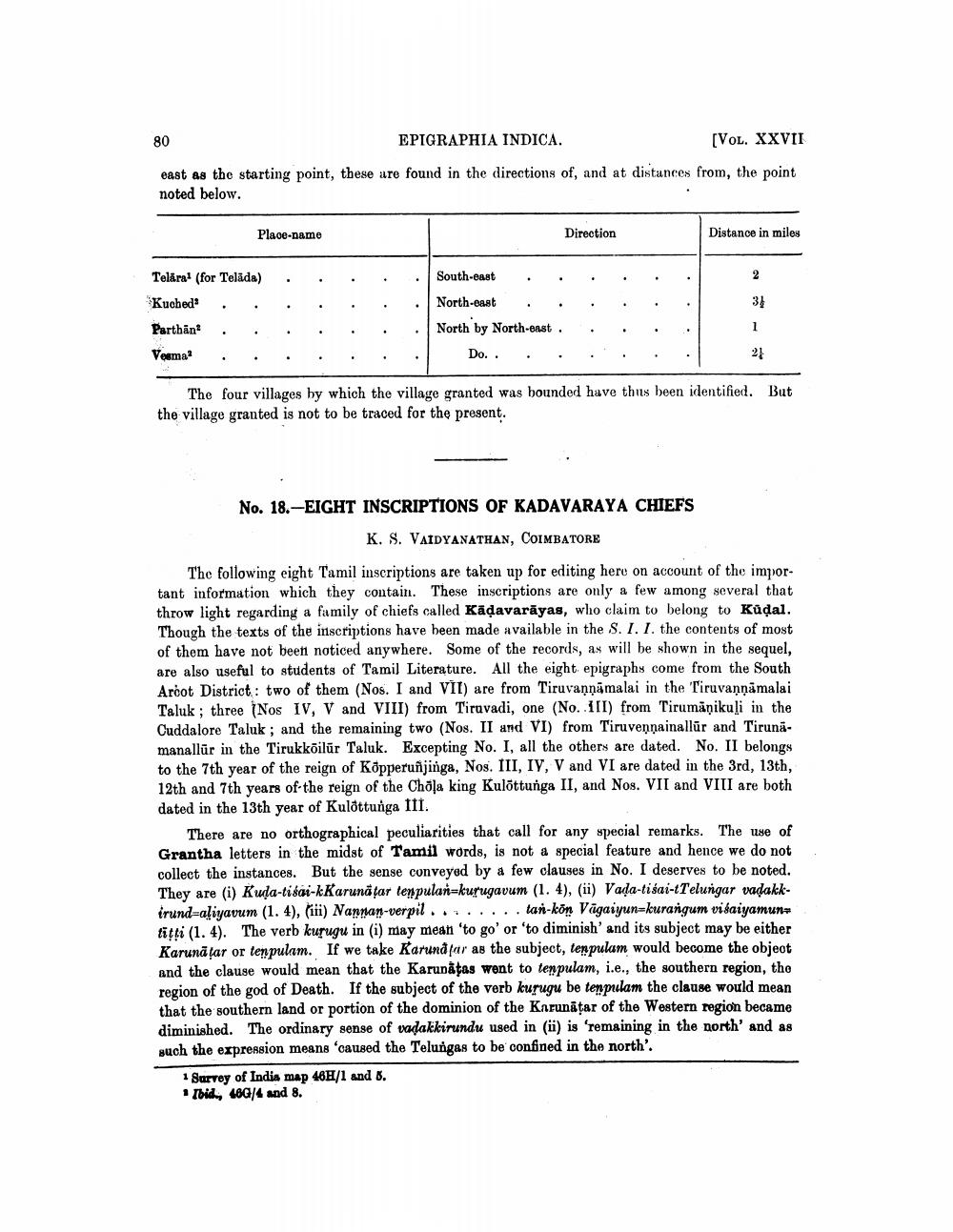________________
80
EPIGRAPHIA INDICA.
(VOL. XXVII
east as the starting point, these are found in the directions of, and at distances from, the point noted below.
Place-name
Direction
Distance in miles
.
.
Teläral (for Telada) Kuched Parthân . . Vesma . .
South-east . . North-east North by North-east .
Do. . . .
.
.
.
. .
. .
. .
. .
. .
The four villages by which the village granted was bounded have this been identified. But the village granted is not to be traced for the present.
No. 18.-EIGHT INSCRIPTIONS OF KADAVARAYA CHIEFS
K. S. VAIDYANATHAN, COIMBATORE
The following eight Tamil inscriptions are taken up for editing here on account of the important information which they contain. These inscriptions are only a few among several that throw light regarding a family of chiefs called Kādavarāyas, who claim to belong to Kudal. Though the texts of the inscriptions have been made available in the S. I. 1. the contents of most of them have not been noticed anywhere. Some of the records, as will be shown in the sequel, are also useful to students of Tamil Literature. All the eight epigraphs come from the South Aroot District: two of them (Nos. I and Vit) are from Tiruvannamalai in the Tiruvannamalai Taluk : three (Nos IV, V and VIII) from Tiruvadi, one (No. 111) from Tirumanikuli in the Cuddalore Taluk; and the remaining two (Nos. II and VI) from Tiruvennainallur and Tirunamanallur in the Tirukkoilur Taluk. Excepting No. 1, all the others are dated. No. II belongs to the 7th year of the reign of Kõpperunjinga, Nos. III, IV, V and VI are dated in the 3rd, 13th, 12th and 7th years of the reign of the Chola king Kulõttunga II, and Nog. VII and VIII are both dated in the 13th year of Kulottunga 111.
There are no orthographical peculiarities that call for any special remarks. The use of Grantha letters in the midst of Tamil words, is not a special feature and hence we do not collect the instances. But the sense conveyed by a few clauses in No. I deserves to be noted. They are (i) Kuda-tibai-kKarunagar tenpulan-kurugavum (1. 4), (ii) Vada-tibai-tTelungar vadakkirund=aļiyavum (1. 4), (iii) Nannan-verpil ........ tan-kön Vāgaiyun-kurangum visaiyamuntipi (1.4). The verb kurugu in (i) may mean to go' or 'to diminish' and its subject may be either Karunāțar or ten pulam. If we take Karundfar as the subject, ten pulam would become the object and the clause would mean that the Karunātas went to tenpulam, i.e., the southern region, the region of the god of Death. If the subject of the verb kurugu be ten pulam the clause would mean that the southern land or portion of the dominion of the Karunatar of the Western region became diminished. The ordinary sense of vadakkirundu used in (ü) is 'remaining in the north' and as such the expression means 'caused the Telungas to be confined in the north'.
1 Survey of India map 48H/1 and 8. 1 Ibid., 466/4 and 8.




